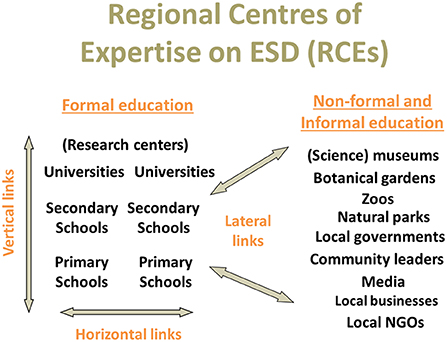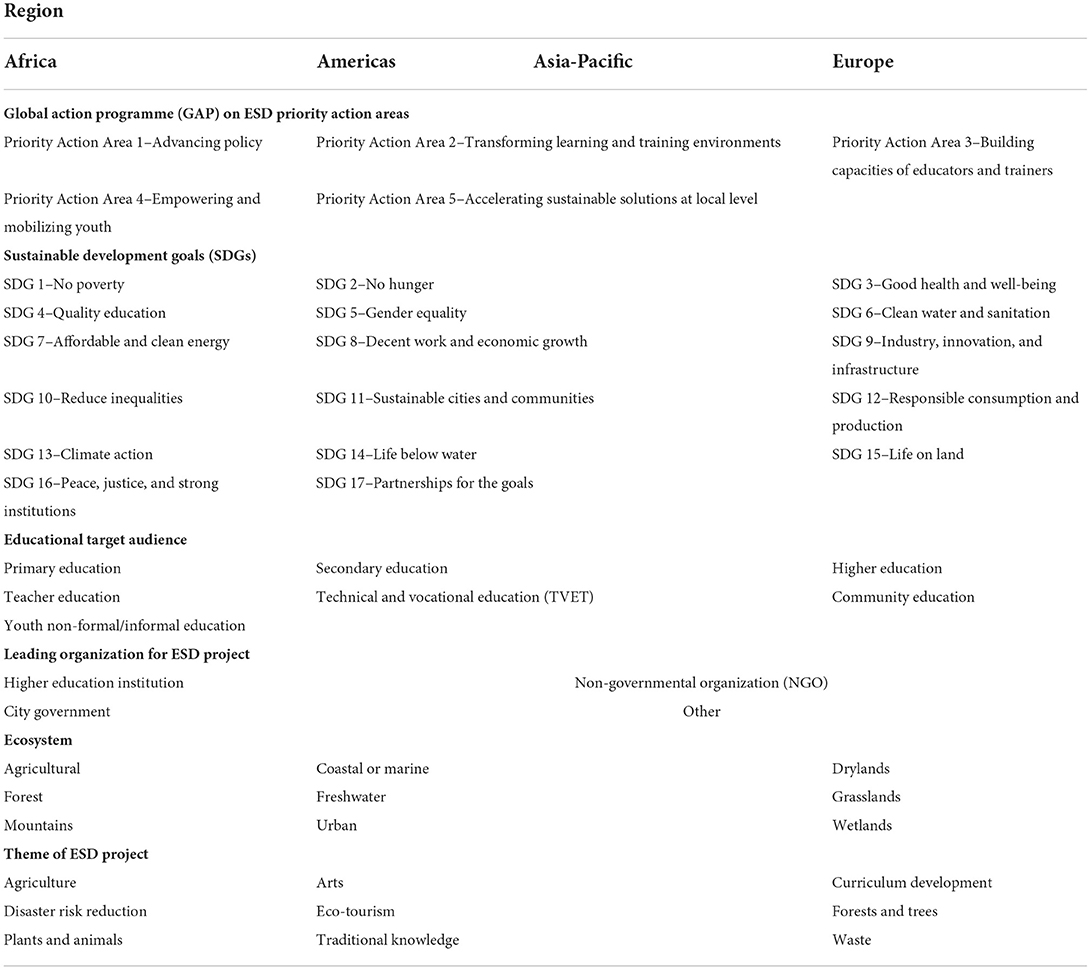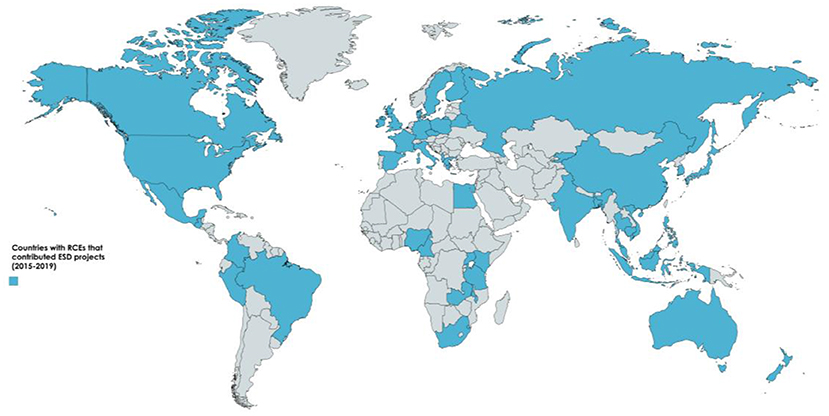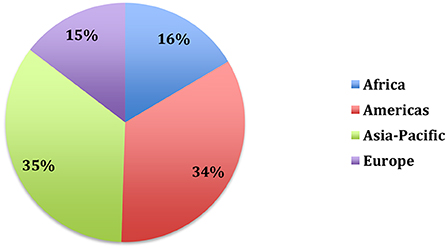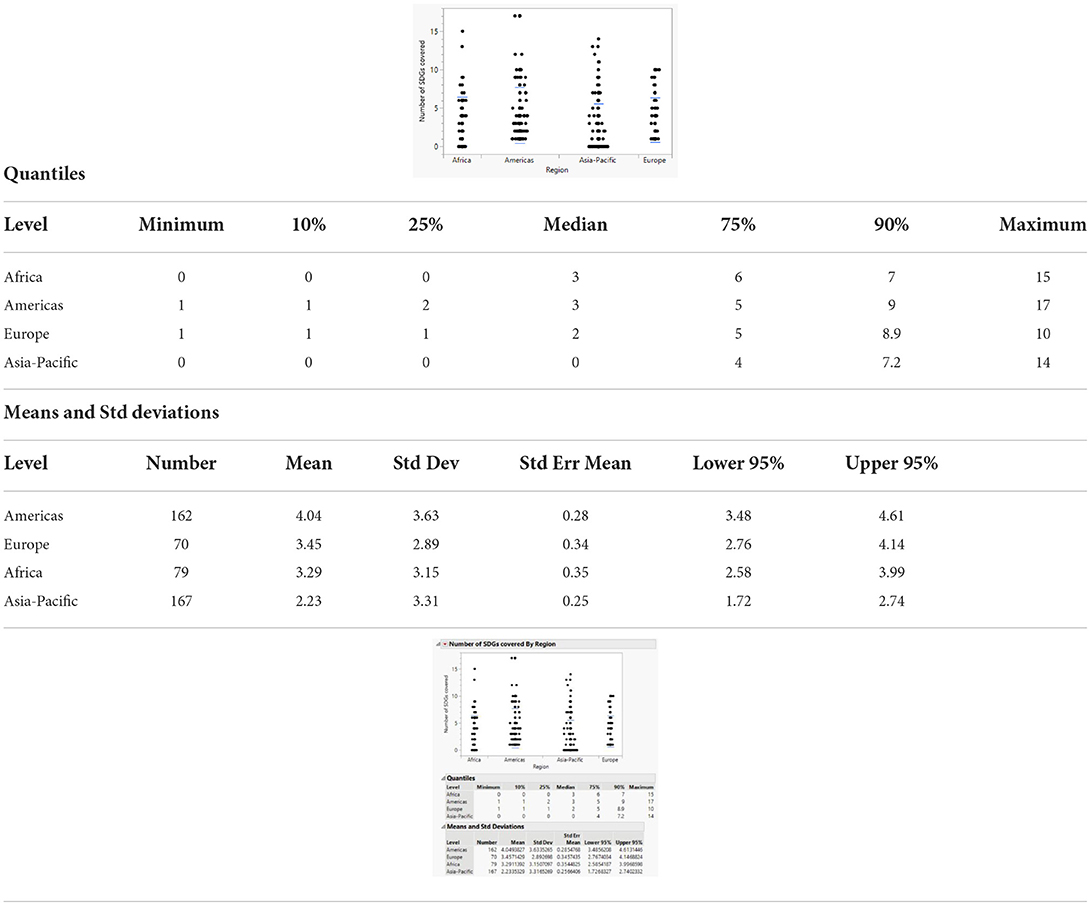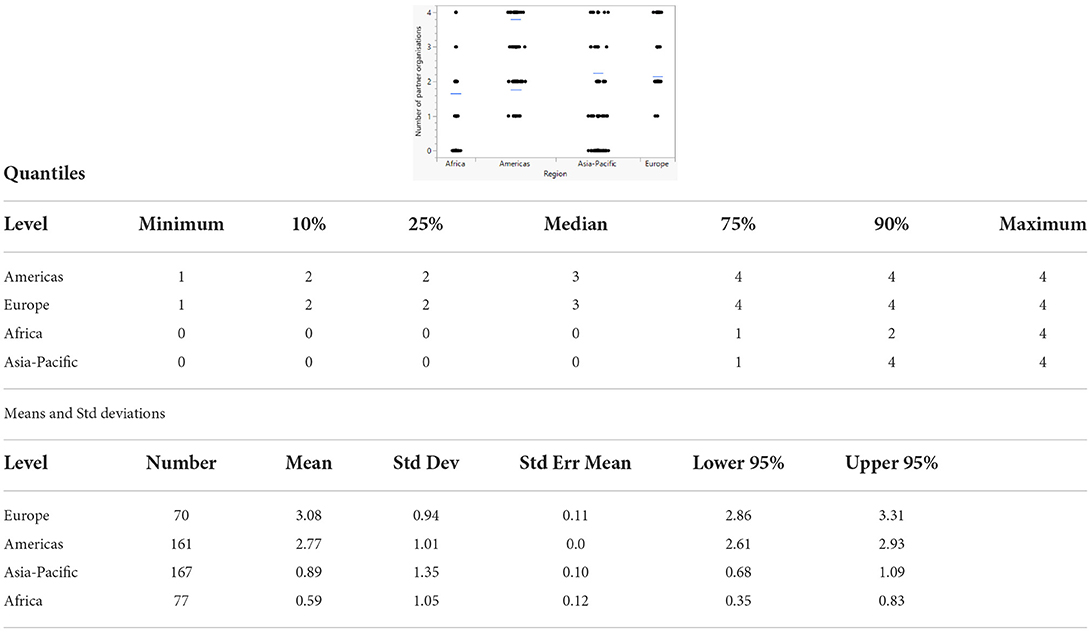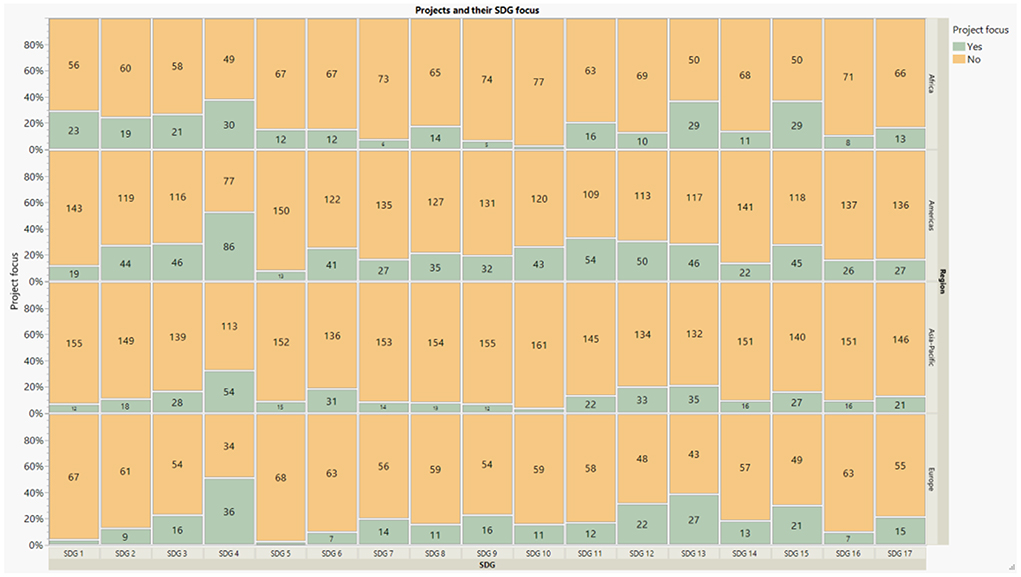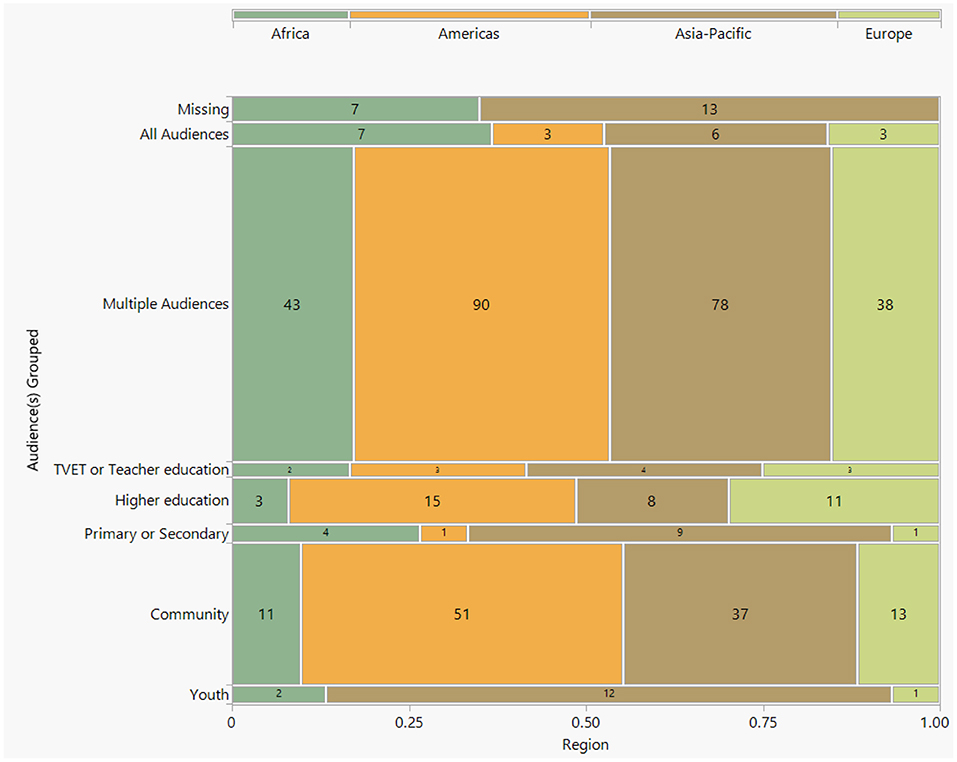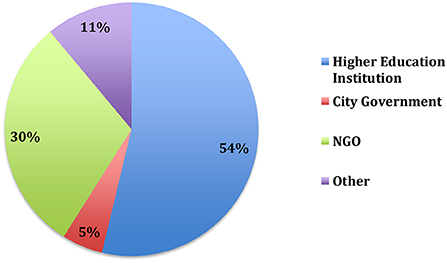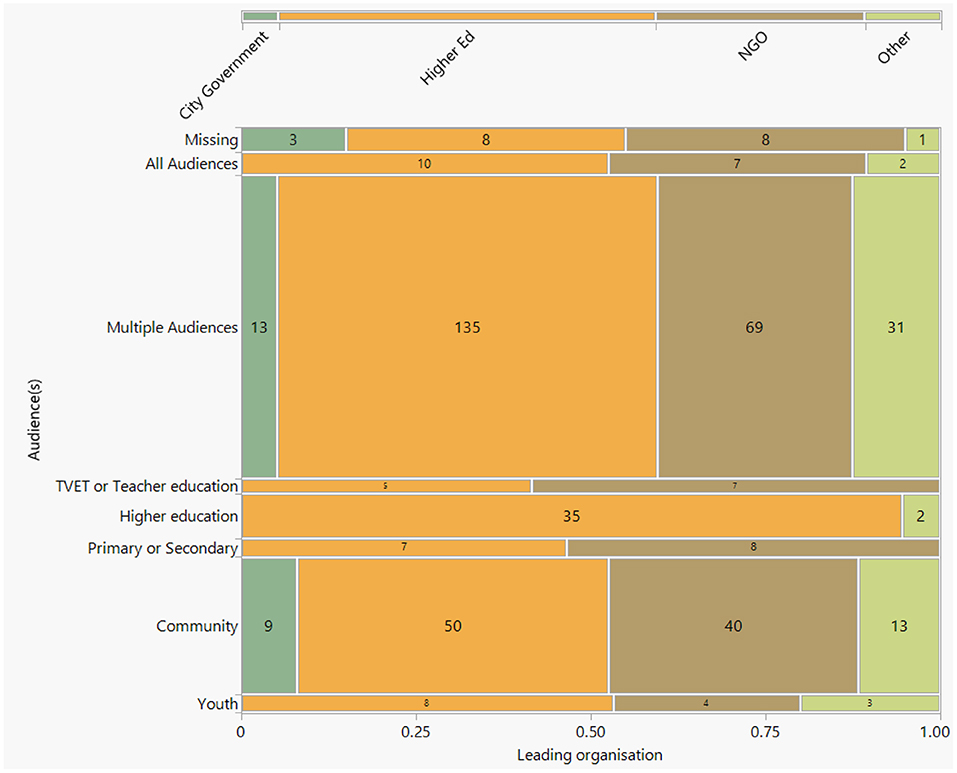Minding the GAP: An overview of five years of Education for Sustainable Development (ESD) projects under the Global Action Programme (GAP) within Regional Centres of Expertise (RCEs) on ESD
- Institute for the Advanced Study of Sustainability, United Nations University, Tokyo, Japan
Research on Regional Centers of Expertise (RCEs) on Education for Sustainable Development (ESD) has focused on how multi-stakeholder and cross-sectoral partnerships can work to enable ESD projects, with a particular focus on how higher education institutions could effectively collaborate with community partners. However, much of this research has focused on how partners worked together (for example, what governance and coordination structures allowed higher education institutions to effectively collaborate with partners) without as much focus of investigation on what activities RCEs were working on. While diverse and compelling research on RCEs already exists, much of this research falls into conceptual theory building or case studies of individual RCE activities. In this article, an overview and analysis of activities from RCEs around the globe is offered to provide some trend analysis for topics and modalities of ESD projects conducted during the Global Action Programme (GAP) on ESD which ran from 2015 to 2019. This empirical analysis can serve as record of where the Global RCE Network has been over the 5 years of the GAP, where it is now, and where it may wish to go in the future.
Introduction
The year 2015 was the beginning of the Global Action Programme (GAP) on Education for Sustainable Development (ESD). Led by the United Nations Education, Scientific and Cultural Organization (UNESCO), the GAP was a follow-up programme to the United Nations Decade of Education for Sustainable Development (UNDESD), which ran from 2005 to 2014. The GAP was designed to further generate and scale-up ESD actions, using education as a mechanism for sustainable development (United Nations Educational, Scientific, and Cultural Organization (UNESCO), 2014) (United Nations Educational Scientific Cultural Organization, 2014). Launched during the same year as the United Nations' Sustainable Development Goals (SDGs) in 2015, the GAP was the result of the Member States recognizing the critical nature of education in implementing the global goals. However, how ESD activities would develop within the context of the SDGs was unknown.
In order to implement ESD activities for the GAP, UNESCO worked with a coalition of partners to coordinate and serve as a global community of practice in relation to ESD. A total of 90 institutions and networks participated from around the world, including national ministries of education and the environment, UN agencies and institutes, local governments, non-governmental organizations (NGOs), student unions, and private sector partners (United Nations Educational Scientific Cultural Organization, 2015) (United Nations Educational, Scientific and Cultural Organization (UNESCO), 2015). While all of the partners involved in the GAP had been working on ESD before the commencement of the GAP, the GAP offered an opportunity to view how these diverse multi-stakeholders could work as a network—or for the network partners, as a network of networks—to innovate and scale up best practices and modalities for implementing ESD.
One of the multi-stakeholder networks serving among these partners during the GAP was the Global Network of Regional Centers of Expertise (RCE) on ESD. With the Secretariat at United Nations University–Institute for the Advanced Study of Sustainability (UNU-IAS), the RCEs have been working as a global network of smaller multi-stakeholder networks since their inception in 2005. RCEs are networks of formal, non-formal, and informal education organizations that facilitate education programmes to enable sustainable development within a given local (often municipal) or regional community. RCEs are partnership networks that include stakeholders such as universities and local school systems that explicitly work with formal education, as well as local governmental bodies, NGOs, museums, zoos, parks, and private sector actors who are engaged in non-formal education and training (United Nations Educational Scientific, and Cultural Organization and United Nations University–Institute for the Advanced Study of Sustianability, 2020) (Figure 1).
As it states within the UN General Assembly resolution on ESD (2020), the concept of ESD has transformed from a target in and of itself (4.7) within Goal 4 of the SDGs (Quality Education) into “a key enabler of all the other SDGs,” with capacity building, learning, empowerment, and knowledge creation providing the foundation to any efforts to address and solve sustainable development problems and issues (United Nations General Assembly, 2020)(United Nations General Assembly, 2020) (United Nations General Assembly, 2020). With ESD being reframed as not only a target of but a critical enabler for the sustainable development agenda, it is critical to use empirical research in order to establish which areas of the sustainable development agenda ESD is being implemented in. Furthermore, identifying key trends in regional, institutional, and other thematic areas of ESD implementation within the contexts of the SDGs will allow for a more nuanced view of ESD programme development in relation to the global sustainable development agenda. A multi-stakeholder network such as the RCEs are a compelling focal point for such an investigation, due to their broad modes of engagement (RCEs work explicitly with both formal school curriculum as well as non-formal education and awareness activities), diverse geographical and cultural contexts (RCEs exist in over 40 countries across Africa, the Americas, Asia and the Pacific, and Europe), the varied topics within ESD (RCE projects work across all 17 SDGs as well as a number of other sustainable development topics and themes).
The aim of this paper is to provide both an overview as well as insight into how the RCEs as multi-stakeholder networks organize and implement ESD activities within their regions within the context of the GAP and the SDGs. In the following sections, the authors provide a description and analysis of how a multi-stakeholder network of ESD actors operated as an implementing partner to the GAP in the first 5 years of the SDGs, from 2015 to 2019. An overview of findings focusing on answering which SDGs and Priority Action Areas were predominant among ESD projects within the network, what types of actors and audiences were involved in these ESD projects, and if there were any broad regional or thematic trends among ESD projects during the GAP is offered in the below analysis. The paper concludes with a discussion of the contributions of RCEs in implementing the GAP, implications of the findings, and possible next-steps for RCEs and other multi-stakeholder partnerships undertaking ESD activities in the future, including for UNESCO's most recent ESD initiative, ESD for 2030.
Background on ESD and the RCEs in the context of the GAP–literature review
During the DESD, education researchers began to conceptualize ESD as a set of competencies that learners at all stages of life should apply to problem solving, as opposed to a definitive topic within formal education curriculums. Building on an earlier framework by Wiek et al. (2011) and Rieckmann (2018) highlights eight competencies that are particularly relevant for learners to achieve within an ESD framework:
• Systems thinking competency: The ability to recognize and understand relationships in complex systems, across different domains and scales;
• Anticipatory competency: The ability to understand and evaluate different futures, thru assessing consequences and dealing with risk and change;
• Normative competency: The ability to understand and reflect on norms and values, in a context of conflicting interests, trade-offs, uncertain knowledge, and contradictions;
• Strategic competency: The ability to develop and implement innovative actions that further sustainability;
• Collaboration competency: The ability to learn from others, facilitate collaborative and participatory problem-solving, and to use respect and empathy when dealing with conflict;
• Critical thinking competency: The ability to question norms, practices, and opinions, and to reflect on one's own values, perceptions, and actions;
• Self-awareness competency: The ability to reflect on one's own role in society, and to evaluate and motivate one's actions; and,
• Integrated problem-solving competency: The ability to apply different problem-solving frameworks to complex problems in sustainable development, so that solutions are viable, inclusive, and equitable.
While the concept of ESD as a set of competencies for learners to master in order to solve problems began to take shape during the DESD, the types of problems learners were being asked to solve began to solidify around specific topics during the GAP. While topical themes within ESD as a field began to be emerge during the UNDESD as well (Læssøe and Mochizuki, 2015), topical themes began to coalesce around the newly announced Sustainable Development Goals (SDGs) during the GAP period. Rather than focusing on where ESD should be inserted into a formal school systems' curriculum, the discourse on ESD during the GAP began to cluster ESD topics around which problems they were intent on solving—and most of these were organized around the SDGs. Rieckmann (2018) notes that SDGs related to climate change, biodiversity conservation, consumption and production, and poverty alleviation became especially prevalent in ESD content and policy objectives by the mid-point of the GAP, but cautions that regional, national, and local contexts could play a significant role in which topics were emphasized in a given location. However, little analysis appears around how regional, national, or local contexts influence topical themes within ESD.
The specific sector of education or audience that ESD was intended to engage with also began to transform during the GAP. While Hallinger and Nguyen (2020) found that research papers on ESD proliferated during the DESD years (2005–2014), most of these focused on formal education of primary and secondary school students. At the beginning of the GAP, Wu and Shen (2016) note the need for increased attention to the role of formal higher education in ESD. By the end of the GAP, ESD in higher education was one of the most rapidly growing knowledge bases within the ESD field (Hallinger and Chatpinyakoop, 2019). But while research into formal education's implementation of ESD proliferated during the GAP, little attention was paid to the role on how these education programmes related to one another (for example, outside of teacher education, little research exists into how ESD for learners in primary or secondary education relates to ESD for learners in higher education, or vice versa). Nor has much attention has been paid to the role of non-formal ESD programmes in the implementation of the SDGs. In order analyze a broader purview of ESD initiatives, it becomes necessary to go beyond analyzing the ESD projects of a given school or school system, and look at ESD projects in the context of a broader educational ecosystem. This educational ecosystem would look something like an RCE.
The concept of the RCEs originated within United Nations University, where the idea of multi-stakeholder networks was proposed as a mechanism for local actors to engage with global sustainable development objectives within the context of their own communities, using education as a tool to implement sustainable development (Glasser, 2008). During the UNDESD, the concept of RCEs proliferated as the network grew and the innovations around multi-stakeholder partnership in ESD began to capture the imagination of university faculties, local school administrators, and local government policy makers who were looking to accelerate action on sustainable development in their own cities and regions (United Nations University – Institute for the Advanced Study of Sustainability (UNU-IAS), 2014) (United Nations University–Institute for the Advanced Study of Sustainability, 2014). In the beginning, research on RCEs focused on how cross-sectoral partnerships could best work to enable ESD projects, with a particular focus on how higher education institutions could effectively collaborate with community partners (Itoh et al., 2008; Brown et al., 2013). The majority of the research on RCEs during the DESD focuses on understanding and explaining the partnerships and coordination structures within RCEs as opposed to any overarching analysis of the ESD activities they were implementing (Fadeeva and Mochizuki, 2010; Urenje, 2010). Additionally, the research during this time period tends to be more descriptive than analytical. The focus on multi-stakeholder partnerships in the literature—RCEs in particular—for much of the UNDESD focused on how partners worked together (for example, what governance and coordination structures allowed higher education institutions to effectively collaborate with partners) without as much focus of investigation on what activities they were working together on. Although research indicates that universities in multi-stakeholder networks were observed to be more proactive in seeking community engagement during the UNDESD (Wals, 2012) (Wals, 2012), what topics or type of projects they were seeking engagement on remains largely undefined within the academic literature. While some case studies are offered, there is little overall analysis of the sum total of ESD projects of a given multi-stakeholder ESD network, including those of the Global RCE Network (Buckler and Creech, 2012).
During the GAP, much research done in relation to multi-stakeholder ESD partnerships, and RCEs in particular, continued the research trend of the DESD, which was to focus on how higher education institutions could (and should) contribute to such partnerships. In their research, Beynaghi et al. (2016) frame possible future university models through social, environmental, and economic orientations toward sustainability, using the RCE model as one model of partnership and collaboration across all three orientations. Isenmann et al. (2016) also use the RCE model for scenario building, specifically in the context of how universities can work with city governments to advance ESD as part of a core mission for both institutions. In their article, Restrepo et al. (2017) showcase how university educators can improve on ESD pedagogy through multi-stakeholder networks such as RCEs, but little detail is given on specific forms of activities per se under this type of pedagogy. The issue of how to improve higher education courses of study using the RCE multi-stakeholder model, particularly around problem-based and applied university progammes of study, is also investigated by Tikhomirova et al. (2015) and Holgaard et al. (2016). The possibility for universities to engage with multi-stakeholder networks through an RCE model to improve both the quality and applicability of university education, as well as scale up sustainable development initiatives at the national level, is explored by studies in the United Kingdom's context (Vargas et al., 2019) and a Central European context (Dlouhá and Glavi, 2017). The RCE model is also examined as a model to transform the field of higher education in general from hierarchal and competitive toward one that is interdependent and collaborative (Poleman et al., 2019). While it is clear that RCEs are seen as vital conceptualization by education researchers as to how higher education should transform to respond to the challenges associated with sustainable development, analysis of what topics and themes universities and other stakeholders are engaging with under the RCE model remain scant.
While much of the research in relation to RCEs during the GAP appears focused on higher education institutions within the RCE network, theoretical and conceptual works that go beyond higher education are also found. Indeed, Wals (2015) cites the RCE model as a concrete example of where schools (formal education) work with community educators (non-formal education). Petry et al. (2015) illustrate that education and learning must be linked to policy actions through a multitude of different actors (not just universities) at the local level through an RCE model to achieve sustainable development outcomes at a sub-national level. This need for formal education institutions, as well as other actors engaged with non-formal education, to go beyond their institutional boundaries by using an RCE model to engage with sustainable development in policy and practice is further explored by Wade (2016) and Dahms et al. (2017). RCEs seem to take central stage in research narratives calling for transformation of what education and learning could and should be in relation to sustainable development, with the need for partnerships as embodied by RCEs' multi-stakeholder model to link formal and non-formal ESD activities and reduce the number of redundant ESD initiatives. The need for such an integrated regional ESD agenda as provided by the RCE model is highlighted in research by Didham and Ofei-Manu (2015), Fernandez and Shaw (2016), and Rauch and Pfaffenwimmer (2015). Shulla et al. (2019) use a Hierarchical Classification Analysis to group RCEs into clusters with similar characteristics, and discuss challenges and possibilities for scaling-up ESD activities in line with the 2030 Agenda under these different RCE operating models. However, here again the focus is on organizational structure of the RCEs and not which topics they were focusing on per se. Kolenick (2020) provides a comparative analysis of RCEs that are working on poverty and health issues (along with Indigenous and traditional ways of knowing). But while these case studies are illuminating, how these particular projects on these particular issues fit within the larger context of the global network's total ESD activities remains unclear.
Other research conducted on ESD activities during the GAP years examines how stakeholders share knowledge within an RCE framework. Wals et al. (2017) analyze RCE projects as case studies for examples of non-formal modalities for community-wide learning during the GAP period. The idea of non-formal and informal community education is also explored in RCE activities in more detail by examining how RCEs facilitate knowledge-transfer though dialogue between RCE partners. In Kolenick (2018) work on green economies, the author notes how RCEs can allow for both bottom-up and top-down knowledge transfer in relation to sustainable consumption and production, as opposed to strictly top-down favored by formal education institutions. Hirsch et al. (2021) expands on this by showcasing how higher education students in an RCE model can collaborate not only to learn about sustainable development, but to create curriculum for other students about it. RCE activities are also analyzed in the context of their linkages with non-formal education actors to formal school systems during the GAP. This is seen with Mahat and Idrus (2016) research on how RCE activities increase teacher and student awareness of the UN sustainable development agenda through partnership with NGOs in Malaysian schools. This is also seen in O'Donoghue et al. (2018) research on how RCEs non-formal education partners in South Africa assisted school environments in transforming toward more sustainable operation models. A thorough analysis of RCE activities across the five GAP priority actions areas emanates from Watson (2015) research on how policy change in education was able to occur at the national level in Scotland through an RCE model and RCE activities by linking formal and non-formal education. By using an RCE multi-stakeholder model to improve communication and better coordinate action between education bodies, government ministries, NGOs, and other stakeholders, the research details how Scotland has been able to advance ESD policies at the national level for primary and secondary education, further and higher education, and non-formal community education. With their explicitly multi-stakeholder structure, and mode of using education as an enabling mechanism for regional sustainable development, researchers throughout the GAP time period propose that RCEs are well positioned to translate global goals into local actions for sustainable development (Yeong et al., 2021).
While diverse and compelling research on RCEs already exists as evidenced by this brief overview, much of this research falls into conceptual theory building or the profiling of individual RCE activities. Hallinger and Nguyen (2020) note that the current knowledge base for ESD since 1990 is heavily weighted toward theoretical, critical, and prescriptive papers in the field, with an insufficient amount of analytical empirical research in the field. The goal of this paper is to add to the analytical empirical research within the field of ESD thru an examination of ESD projects within the RCE network during the GAP from 2015 to 2019 by addressing the following questions:
• What regional trends are apparent among ESD projects implemented by RCEs during the GAP?
• Which SDGs and Priority Action Areas (PAAs) of the GAP are the predominant focus for ESD projects among RCEs during the GAP?
• What type of audiences and institutions are ESD projects engaging with during the GAP?, and
• What other thematic trends occur within ESD projects implemented by RCEs during the GAP?
The preceding questions are an entry point to analyzing the data rather than a comprehensive list of all analysis possible with the existing dataset. In what follows, an overview and analysis of activities from RCEs around the globe is offered to provide some empirical trend analysis for topics and modalities of ESD projects conducted during the GAP. This analysis can not only serve as record of where the Global RCE Network has been, but also a starting point for conversation about where it may wish to go in the future.
Methods
The primary data sources for this research were RCE project reports from the RCE portal's archives. As part of their conditions for acknowledgment, RCEs are required to submit regular project reports on ESD initiatives they undertake during the course of a given calendar year. An RCE can undertake as many ESD projects as they wish over the course of a year, as the network is designed to allow for RCEs to operate under their own capacities with regards to resources, time-lines, and thematic areas of focus. Projects varied in length from 1 week to one full calendar year. If a project runs over one calendar year, RCEs are asked to create separate project reports for each year a given project operates in order to update data collection on the project. All projects were completed by the end of the GAP, though some successful projects have been renewed after the GAP years. Projects vary widely in scope, scale, and audiences that are engaged with the given project.
The following methodological steps were undertaken in order to collect and analyzes the data from the RCE project reports: (1) Formulation of a search strategy to identify and tag data within the text of the RCE project reports; (2) Delineation of the time period for the dataset and data collection through content analysis and data tagging of the RCE project reports from this time period; (3) Data analysis and information processing.
(1) Formulation of a search strategy to identify and tag data within the text of the RCE project reports
In order to create as comprehensive an analysis as possible, the research team decided to use a combination of deductive (starting with a predefined set of codes) and inductive coding (deriving the codes from the data itself) for all of the RCE project reports submitted on the RCE portal for analysis. These codes have subsequently been used to create a codebook as well as to guide the RCEs in project reporting through a series of data tags that allow RCEs to tag their reports with various data labels for categorization purposes. The following categories and data tags were developed by the research team for the codebook:
• Region: A deductive code, with data tags developed for regions based on the regional organization within the RCE Global Network, which is in turn informed by the United Nations geoscheme1;
• GAP priority action areas: A deductive code, with the categories for the data tags being the five GAP Priority Action Areas;
• Sustainable development goals (SDGs): A deductive code, with the categories for the data tags being the 17 SDGs;
• Audience: An inductive code, with the categories for the data tags being the intended educational target audience(s) for a given RCE project;
• Leading organization: An inductive code, with the categories for the data tags being the type of institution (university, local government, NGO, etc.) that served as the coordinating organization for a given RCE project (though not necessarily the RCE's governing secretariat);
• Ecosystem: An inductive code, with the categories for the data tags being the type of ecological setting(s) that a given RCE project was conducted in and about; and,
• Theme: An inductive code, with the categories for the data tags being a list of common key words and concepts (for example, curriculum development, traditional knowledge, etc.) that appeared repeatedly within RCE project reports.
For a complete list of all data tags generated by the research team, see Table 1.
(2) Delineation of the time period for the dataset and data collection through content analysis and data tagging of the RCE project reports from this time period
The time period for analysis was then selected to be from 2015 to 2019, the entirety of the GAP as well as the first 5 years following the launch of the SDGs. Once the research team had created the codebook, all RCE project reports submitted during the GAP (n = 479) were coded using the data tags from the codebook.
(3) Data analysis and information processing
Following the coding of all of the RCE project reports submitted during the GAP, a quantitative analysis of the data from all of the reports was undertaken by the research team. Quantitative data on all of the data tags for the RCE project reports were uploaded into Microsoft Excel software on a shared drive, allowing for shared access by the research team members. Data entry for each of the RCE project reports was entered by one member of the research team, and validated by a separate member of the research team in order to avoid duplication and check for accuracy in data entry.
After the quantitative data from all of the data tags from all of the RCE project reports had been entered and validated, a statistical analysis of the dataset was run using Excel and SAS Jmp Pro, which included descriptive quantitative analysis, multiple linear regression, and logit regression techniques. This statistical analysis was done in order to quantify to what extent a given data tag appeared in a given category, as well as to describe how the data within the categorical datasets related to one another.
The researchers used this statistical analysis to illustrate trends and gaps among subjects and modalities of ESD activities in the network during the given timeframe. During analysis, the researchers were interested not only in categories that occurred in high frequency, but also those that occurred in low frequency, which can point to gaps, or at least absences, in the data. The following sections are based on this analysis and provide an overview of some of the findings from the quantitative content analysis of RCE project reports from around the world during the GAP.
Results
Regional analysis for RCE projects
A total of 479 RCE project reports from 46 different countries around the world (Figure 2) were submitted to the Global RCE Service Centre during the GAP between January 2015 and December 2019.
A regional overview of where RCE projects emanated from during the GAP is presented in Figure 3, with the bulk of RCE projects coming from Asia-Pacific and the Americas.
In terms of the scope of SDGs that RCE projects addressed, projects that took place in the Americas tended to cover the most SDGs, with four SDGs on average per project in the region. This is compared to RCE projects within Africa, Asia-Pacific, and Europe which tended to focus on fewer SDGs but often in greater detail (Table 2).
Furthermore, RCE projects in Europe and the Americas tended to involve more organizations in the implementation of a project than RCE projects in Africa or Asia-Pacific (Table 3).
In terms of contributions from individual countries, the greatest number of RCE projects came from the United States (n = 103), Malaysia (n = 66), India (n = 34), Nigeria (n = 29), and Mexico (n = 27). Interestingly, all five of these countries are federal republics, with educational policy often delegated from the national level to the state level. Therefore, RCEs working in these nations most likely interact with state-level as opposed to national level government ministries/departments on many policy issues related to ESD.
Analysis of GAP priority action areas for RCE projects
Over half of all RCE project reports submitted during the GAP included engagement with Priority Action Area 5—Accelerating sustainable solutions at the local level, while over one-third of all RCE projects reports submitted during the GAP included engagement with Priority Action Area 4—Empowering and mobilizing youth (Figure 4). Nearly one-third of all RCE project reports submitted during the GAP integrate Priority Action Area 2—Transforming learning and training environments into their ESD activities. Of all of the Priority Action Areas under the GAP, only Priority Action Area 1—Advancing policy, had less than 20% of all RCE projects reporting significant engagement with policy processes, whether at the local, sub-national, or national level.
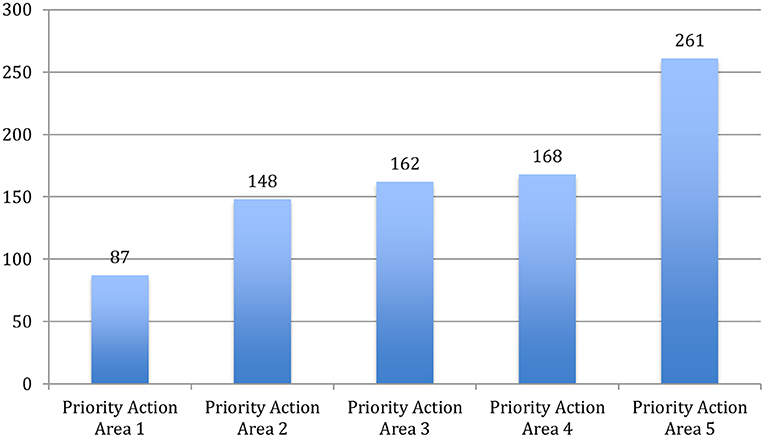
Figure 4. RCE projects reports tagged by GAP Priority Acton Area (2015–2019). n > 479, as RCEs were able to tag more than one GAP Priority Action Area if the RCE project incorporated more than one. For example, an RCE project may have worked with training youth as educators (Priority Action Area 4), and then facilitated the same youth to work on public awareness campaigns on ESD for an entire community (Priority Action Area 5), thus the project would have two tags for this variable.
The global trend for engagement with the different GAP Priority Action Areas remains consistent for RCE project reports at the regional level in Africa and the Americas, however differs somewhat for Asia-Pacific and Europe. Nearly half of RCE project reports submitted by European RCEs engaged with Priority Action Area 3—Building capacities of educators and trainers, whereas only a little over a third of RCE project reports from other regions reported engaging with teacher training. Teacher training was especially apparent in the ESD activities of RCE project reports from France, England, Germany, and Scotland. In addition, engagement with Priority Action Area 5—Accelerating sustainable solutions at the local level, was present in over half of ESD projects in other regions, but present in less than one-third of RCE projects from the Asia-Pacific region. While all regions submitted RCE project reports that engaged with more than one of the GAP Priority Action Areas, the median number of GAP Priority Action Areas engaged per RCE project was slightly higher in Africa (2) than the other regions.
Analysis of sustainable development goals within RCE projects
Because all RCE projects are in and of themselves education initiatives, every RCE project reported during the GAP touched upon SDG 4 (Quality Education), specifically positioning activities around Target 4.7 within SDG 4 on Education for Sustainable Development.
Goal 4—Target 4.7—“By 2030, ensure that all learners acquire the knowledge and skills needed to promote sustainable development, including, among others, through education for sustainable development and sustainable lifestyles, human rights, gender equality, promotion of culture of peace and non-violence, global citizenship and appreciation of cultural diversity and of culture's contribution to sustainable development” (United Nations General Assembly, 2020).
Apart from Goal 4, RCE projects within the global RCE network during the GAP also had a significant focus on Goal 13 (Climate Action), Goal 15 (Life on Land), Goal 12 (Responsible Consumption and Production), and Goal 3 (Good Health and Wellbeing) (Figure 5).
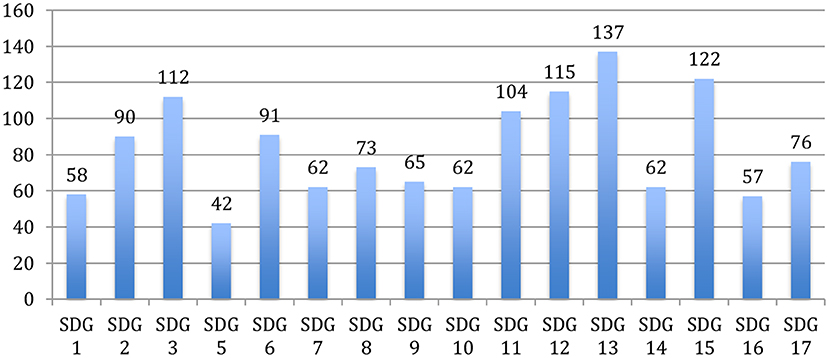
Figure 5. RCE project reports tagged by Sustainable Development Goal (SDG), omitting SDG 4 (Quality Education) during the GAP (2015–2019). n > 479, as RCEs were able to tag more than one Sustainable Development Goal (SDG) if the RCE project incorporated more than one. For example, an RCE project worked with education to teach how to respond to climate change by forest conservation, SDGs 13 (Climate Action) and 15 (life on Land) would both be tagged.
The high frequency of RCE projects working on some of the Sustainable Development Goals directly related to environmental governance is to be expected, given that ESD has been formally integrated into many sustainable development frameworks and conventions on the environment prior to the launch of the GAP or the SDGs. These include Article 6 of the United Nations Framework Convention on Climate Change (UNFCCC) and its work programmes, Article 13 of the Convention of Biological Diversity (CBD) and its work programmes, and the Sustainable Lifestyles and Education Programme of the 10-Year Framework of Programmes on Sustainable Consumption and Production (10-YFP on SCP) (2012–2021) (United Nations Educational, Scientific and Cultural Organization (UNESCO), 2014) (United Nations Educational Scientific Cultural Organization, 2014). In fact, all three of these conventions/frameworks are referenced frequently within the RCE projects reporting on these respective topics. The only major exception to this trend among the top four most-cited SDGs is RCE projects working on Goal 3 (Good Health and Wellbeing), which cover a wide variety of health and sanitation issues, but no single framework or convention around health is referenced more than once among all submitted RCE projects. The attention to SDG 13 (Climate Action) in particular—which is the most frequently tagged SDG among RCE projects during the GAP—is supported in the academic literature. Læssøe and Mochizuki (2015) highlight the RCE model as one being used by national governments looking to expand ESD on climate change beyond the formal education sector, with Sung (2015) highlighting the case of RCEs working on climate change education within South Korea as a national case.
Statistical analysis of RCE projects using logit regression, whole model test, and prediction profilers were used to analyzes which audiences of learners were more likely to be the focus of RCE projects on the two most cited SDGs from the RCE project reports. The effect summary and parameter estimates for logit regression indicate that RCE projects that target primary education, higher education, and/or informal youth education are more likely to be focused on SDG 13 (Climate Action), while RCE projects that target higher education are more likely to focus on Goal 15 (Life on Land) (Table 4). While whole model tests for both SDG 13 (Climate Action) and SDG 15 (Life on Land) were significantly different from the null model, the low R2 indicates a lack of fit, meaning there may be variables other than educational audience that influence whether RCE projects focus on either of these two SDGs. Nevertheless, the result of the whole model test provides meaningful information on whether RCE projects are focusing more on these SDGs for specific audiences (Table 5). The prediction profiler further showcases that RCE projects that target primary education, higher education, and/or informal youth education are more likely to focus on SDG 13 (Climate Action), and that RCE projects that target higher education audiences are more likely to focus on SDG 15 (Life on Land) (Table 6).
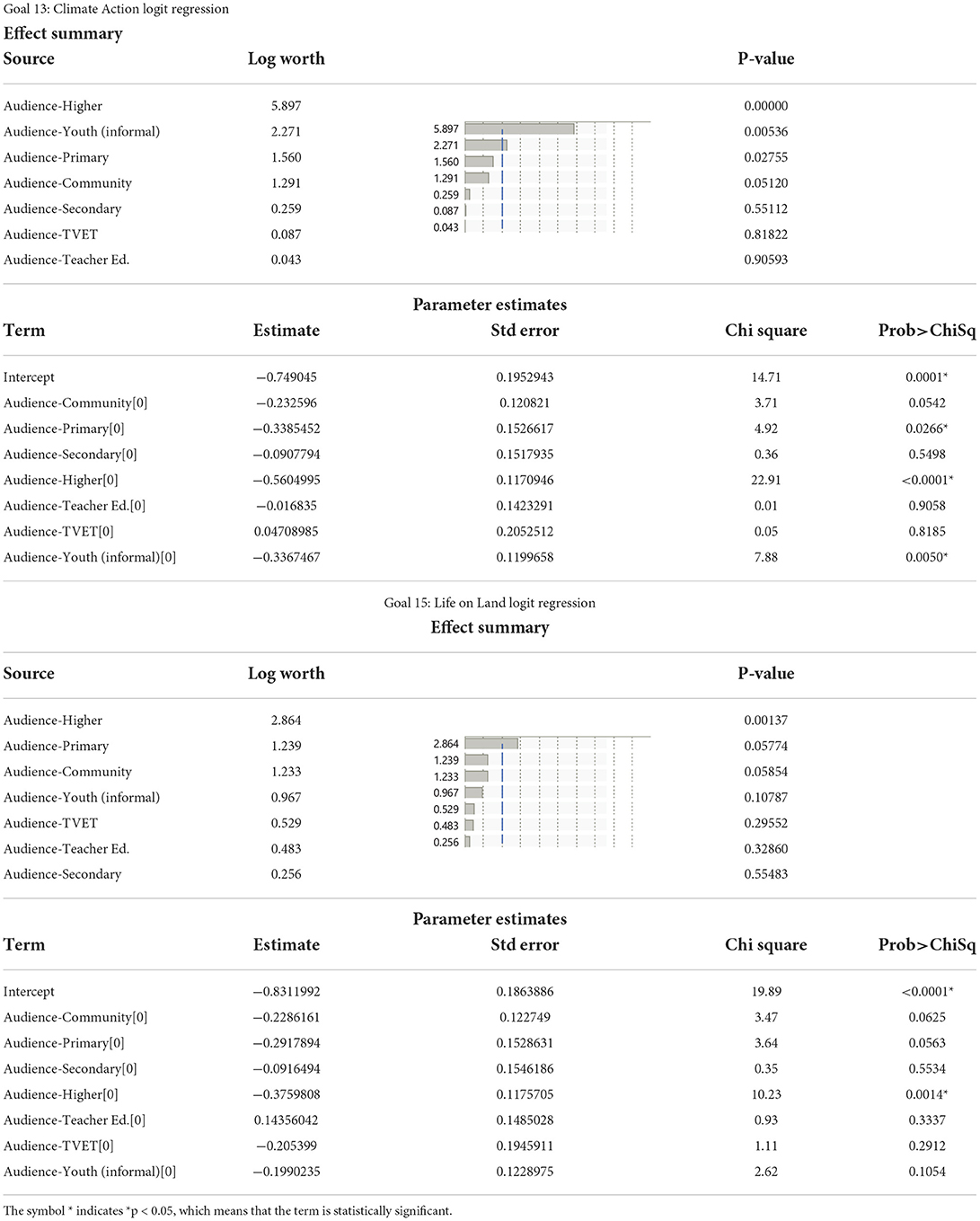
Table 4. Effect and parameter estimates on the likelihood of RCE projects to focus on specific audiences of learners for SDG 13 (Climate Action) and SDG 15 (Life on Land).
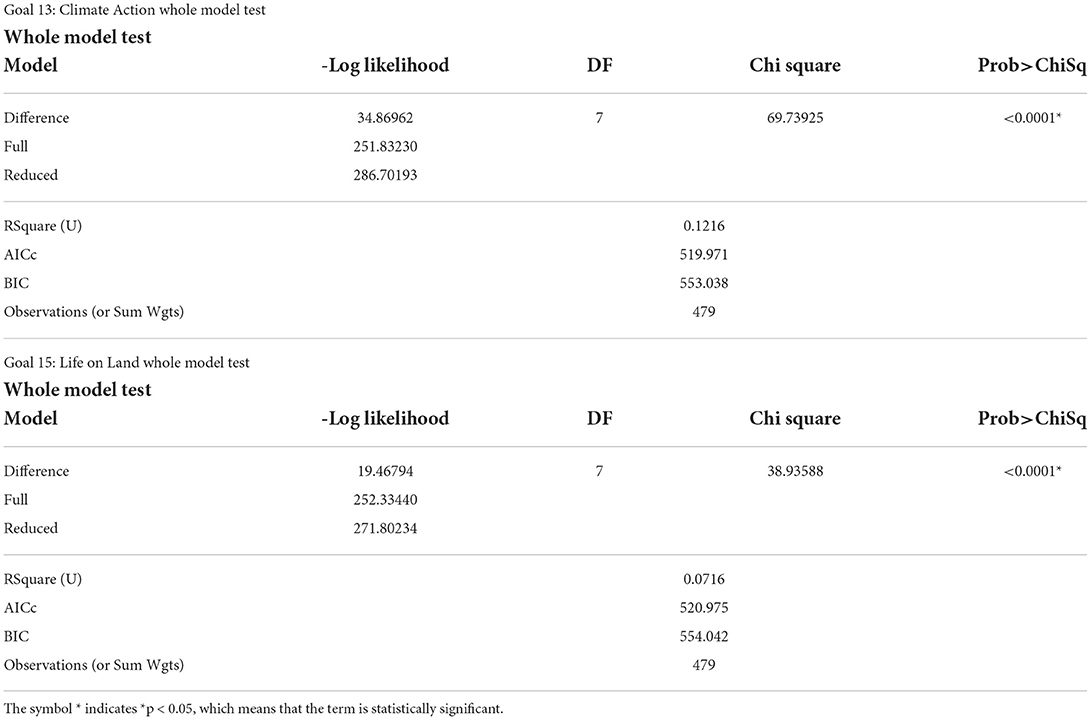
Table 5. Whole model test on the likelihood of RCE projects to focus on specific audiences of learners for SDG 13 (Climate Action) and SDG 15 (Life on Land).
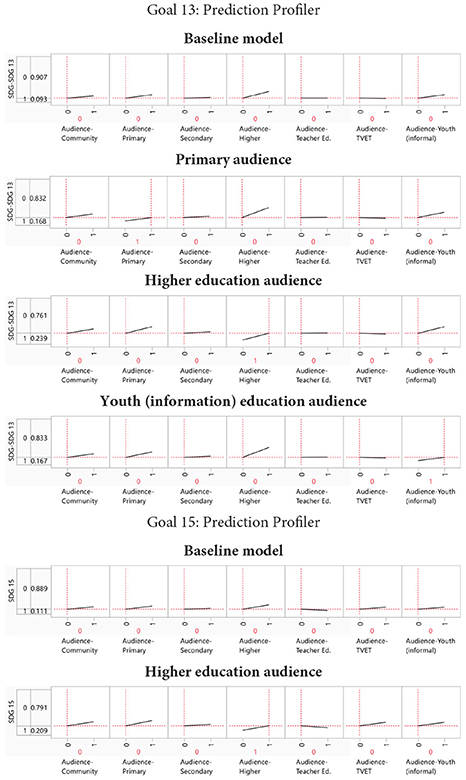
Table 6. Prediction profiler on the likelihood of RCE projects to focus on specific audiences of learners for SDG 13 (Climate Action) and SDG 15 (Life on Land).
The predominance of SDGs 13 (Climate Action) and 15 (Life on Land) at the global level of analysis is only seen in one of the four regions—Africa—when looking at a regionalized analysis of the data. SDGs 13 (Climate Action) and 12 (Responsible Consumption and Production) are the top two SDGs within European and Asia-Pacific RCE project reports, while RCE project reports submitted from the Americas most frequently cite SDG 11 (Sustainable Cities and Communities), followed by SDG 12 (Responsible Consumption and Production), and SDG 3 (Good Health and Wellbeing). SDGs related to the bio-physical environment, such as SDG 13 (Climate Action) and SDG 15 (Life on Land) are less predominant in project reports emanating from RCEs in the Americas during the GAP, and when these SDGs are tagged, tend to be integrated in ESD curriculum covering all SDGs as opposed to ESD activities that are particularly focused on either climate change or terrestrial biodiversity conservation. This is a different trend than in ESD projects seen in RCE reports from Africa, Asia-Pacific, and Europe (Figure 6).
Globally, the least tagged SDGs within RCE project reports are Goal 5 (Gender Equality), Goal 16 (Peace, Justice, and Strong Institutions), Goal 7 (Affordable and Clean Energy), and Goal 10 (Reduced Inequalities).
Analysis of audience within RCE projects
The majority of RCE projects in each region targeted multiple educational audiences within a given RCE project (Figure 7). While RCE projects reported during the GAP targeted a wide variety and combination of educational audiences across formal and non-formal education settings, nearly two-thirds of all RCE projects had a non-formal community education component (Figure 8). Typically, these took the form of public awareness campaigns supplemented by symposiums, workshops, and trainings. For projects that target a single audience, community is the largest audience among all RCE projects. Over one-third of all RCE projects reported incorporating a non-formal youth education component, usually with youth taking leadership positions in community education project after receiving training. How these particular projects contributed to empowering youth in terms of capacity building and degree of participation should be further analyzed. This global trend is consistent across all regions.
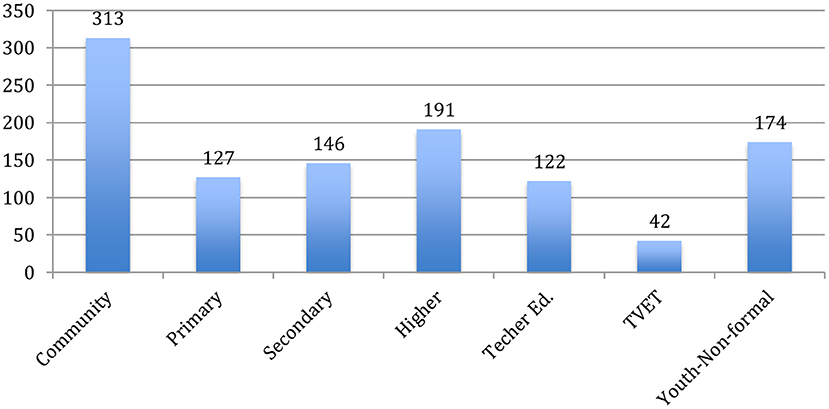
Figure 8. RCE projects reports tagged by educational audience during the GAP (2015–2019). n > 479, as RCEs were able to tag more than one educational audience if the RCE project incorporated more than one. For example, an RCE project worked with training youth in a non-formal ESD, youth may have then gone on to create a public awareness campaign for an entire community, and the project would have two tags for this variable.
Within formal educational settings, the greatest proportion of RCE projects occurred in a higher education setting, typically a university in the form of a course or programme of study at the Bachelor's or Master's level. Because information about teacher training activities were reported to UNESCO during the GAP, all projects using the tag for teacher education were counted as a discrete category, whether this included the education of new teachers or the training and up-skilling of existing teachers. As mentioned previously under Priority Actions Areas of the GAP, teacher education was cited as a component of ESD activities in a greater proportion of European RCE projects compared to other regions. Primary and secondary school learners are incorporated into approximately one-fourth and approximately one-third of all RCE projects, respectively. With few exceptions, engagement with both primary and secondary schools tends to be at the individual school level, and not at the school system level. Across all regions, technical and vocational education and training (TVET) was the least tagged for educational audiences, showing a lack of RCE projects engaging with workforces and trades training in relation to ESD.
Analysis of leading organization within RCE projects
Globally, over half (54%) of RCE projects submitted during the GAP were coordinated by a university or other type of higher education institution as the leading organization or secretariat for a project. NGOs were the second most common leading organization, with 30% of RCE projects being led by NGOs (Figure 9).
The role of city governments as coordinating actors on RCE projects varies greatly by region, with approximately 10% of all RCE projects in both Europe and Asia-Pacific headed by city governments, but less than 1% of all RCE projects in both Africa and the Americas led by city government. Indeed, any involvement of city or other local government at all in RCE projects is exceedingly rare in both Africa and the Americas, with less than 3% of RCE projects from either region involving any type of government partners in RCE projects during the GAP period.
Eleven percent of all RCE projects reported during the GAP were led by actors outside of academia, local government, or the NGO sphere. This assortment includes members of the private sector, local media outlets, museums, national park systems, and UN agencies based in specific localities. Despite a wide range of diversity among these actors, no sector within this group accounted for more than 1% of the lead organizations in the total number of RCE projects reported. With the RCE model being explicitly multi-stakeholder, it is intriguing to observe that private sector actors rarely took on a leadership role in reported ESD activities. Nor did many museums or park systems, despite non-formal education institutions such as these being prolific in non-formal education.
All leading organizations predominantly focused on projects for multiple educational audiences and for community education audiences. However, ESD projects targeting primary or secondary learners only emanated exclusively from higher education institutions or NGOs (Figure 10).
Analysis of ecosystems within RCE projects
Over half (53%) of all RCE projects reported during the GAP had a component on ESD in urban environments. This is perhaps unsurprising, given that the 2018 Revision of the World Urbanization Prospects (United Nations Department of Economics and Social Affairs (UN DESA), 2018) (United Nations Department of Economics Social Affairs, 2018) notes that humanity is a rapidly urbanizing species, with 68% of the total global population projected to live in cities by 2050. Many of the RCE projects during the GAP period included ESD activities on sustainable urban development, with themes of urban design, food supply chains, waste management, and water consumption recurring frequently among different RCEs. As previously noted, the Americas region was particularly focused on sustainable urban environments, with Goal 11 (Sustainable Cities and Communities) being the most frequently tagged SDG among all RCE projects in the region. ESD activities around housing and transit in urban environments were also significantly higher among RCE projects of the Americas compared to other regions.
Ecosystem settings for ESD activities that also featured prominently in RCE projects during the GAP included agricultural production systems (25% of total projects), freshwater ecosystems—such as rivers and lakes (19% of total projects), and forest ecosystems (17% of total projects; Figure 11).
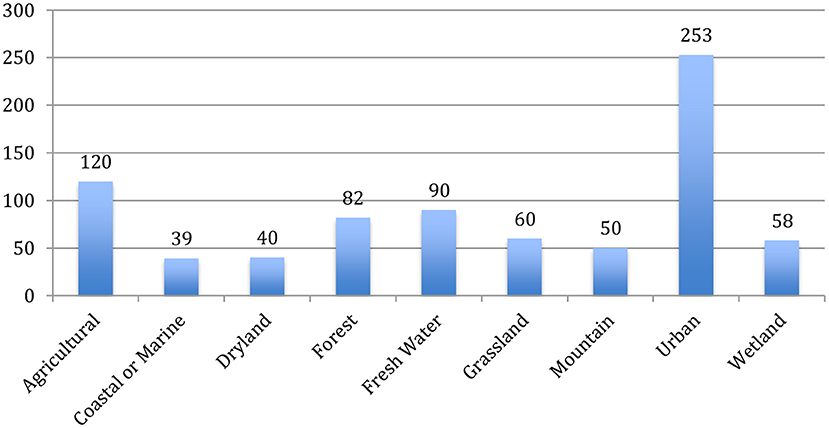
Figure 11. RCE projects by ecosystem setting during the GAP (2015–2019). n > 479, as RCEs were able to tag more than one ecosystem if the RCE project incorporated more than one. For example, an RCE project worked with training school students about sustainable food supply in an urban setting, it also may have worked with training farmers in an agricultural setting, and the project would have two tags for this variable.
The bulk of the RCE projects set in these ecosystems focus on the sustainable consumption of resources produced by these ecosystems, such as crops, drinking water, and timber. While RCE projects set in these ecosystem settings stress sustainable usage of resources, the focus of the ESD activities in these ecosystems is very much set in the context of ensuring a high quality of life for local communities. The conservation of resources and biodiversity in forests or fresh water ecosystems tends to be framed anthropocentrically, in terms of what benefits local inhabitants may reap over the long term as opposed landscapes or other species having intrinsic value in and of themselves. However, RCE projects set in more marginal landscapes such as mountains, drylands, or wetlands tend to frame conservation of resources and biodiversity as more intrinsic values in ESD activities. This may suggest that RCEs frame ESD activities around intrinsic values of nature more often when ecosystems are not the target or resource extraction by human populations. Few RCE projects focused on coastal or marine ecosystems, despite a high number of RCEs situated in coastal regions.
Analysis of themes within RCE projects
In order to capture the nuance and diversity among RCE activities, a category titled ‘theme' was created from an inductive coding exercise using RCE project reports submitted during the UN DESD. The data tags created from this coding exercise fall outside of any formal categorization linked to a UN agency agenda working on ESD, but are useful in capturing details among RCE projects that would otherwise be overlooked (Figure 12).
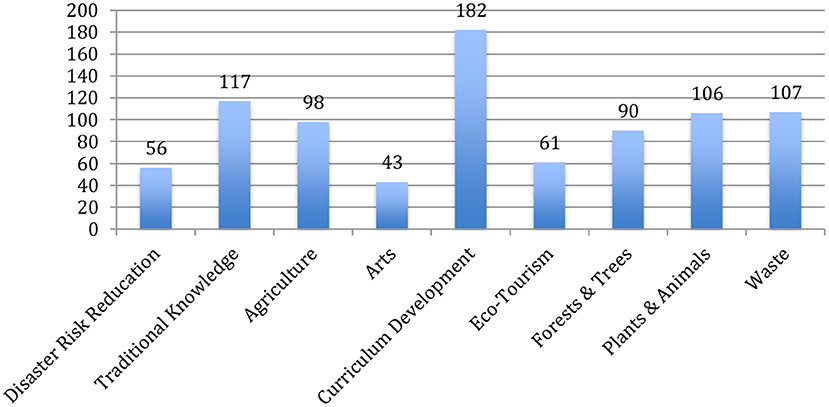
Figure 12. RCE projects by theme during the GAP (2015–2019). n > 479, as RCEs were able to tag more than one theme if the RCE project incorporated more than one. For example, an RCE project worked with curriculum development may also have worked on incorporating traditional knowledge into curriculum, and the project would have two tags for this variable.
The most frequently cited data tag for theme of RCE project reports during the GAP is curriculum development (38% of total RCE projects), referring to the creation of guidelines for a planned sequence of instruction activities. While some RCE projects working on curriculum development reported updating existing curriculum to incorporate ESD principles, the majority of reports highlighted creating new curriculum from scratch. This was especially prevalent among RCE projects led by universities, with educators working in formal education reporting existing curriculum being insufficient. Many reports on curriculum development highlighted existing curriculum being out-dated, with university educators stressing text books and class syllabi were being used for teaching students a twentieth century concept of development in a twenty-first century world. This sentiment was echoed across curriculum development projects for primary, secondary, and higher education.
Additional themes of ESD activities with RCE projects that were frequently cited include traditional knowledge (24% of total RCE projects), waste education (22% of total RCE projects), and individual plant and animal species (22% of total projects). RCE projects incorporating elements of traditional knowledge occurred in over 20% of each region's total number of RCE projects. However, while Traditional knowledge tended to be refer explicitly to the knowledge and practices of Indigenous Peoples within RCE projects reported from the Americas and the Asia-Pacific region, RCE projects reported from Africa and Europe tended to frame traditional knowledge in terms of intergenerational knowledge transfer and practices from within rural communities. RCE projects that included a focus on the theme of waste education (22% of total projects) tended to champion teaching waste sorting practices, and capitalizing on the 3Rs—reduce, reuse, recycle—many using pedagogies which were introduced in public awareness campaigns beginning in the 1970s (Winans et al., 2017). A number of RCE projects also incorporated themes of teaching about particular plant and animal species (22% of total projects), with most RCE projects using this species-focused entry point as a foundation to conserve a wider ecosystem. While disaster risk-reduction made up a significant amount of RCE projects reported from the Asia-Pacific region—especially in regards to earthquakes, flooding, and tsunamis and explicitly linking to the Sendai Framework for Disaster Risk Reduction– other regions reported comparatively few projects in relation to this theme.
Discussion and conclusion
The overview presented here is a snapshot of RCE activities reported to the RCE Global Service Centre over a specific period of time—from 2015 to 2019—during the Global Action Progamme for ESD. The analysis is meant as a window offering a glimpse of ESD activities within the Global RCE Network during the GAP, and is not meant as an authoritative boundary that assumes perfect information about all RCE activities around the globe. Nor is it meant as a value judgment—when little activity is observed around one given issue, it is not an implicit instruction for RCEs to engage with it, nor when much activity is observed is it an implicit instruction for RCEs to diversify. Because RCEs are localized multi-stakeholder networks, they themselves are in the best positions to decide what the priorities for sustainable development are and should be within their own communities.
Rather, the analysis presented here is a starting point for dialogue about what has been done (and reported) over a 5-year period of activities.
Regional trends
While further analysis will greatly enrich the narratives around this data, clear trends around ESD are apparent in this initial overview. During the GAP period, the majority of ESD projects within the Global RCE Network emanated from Asia-Pacific and the Americas. While all RCE projects are designed to be multi-stakeholder projects with at least two organizations involved, RCEs in Europe and the Americas tended to work with a larger number of partners on average than RCEs in Africa and the Asia-Pacific region. RCEs in the Americas tended to incorporate a greater number of SDGs into ESD projects for a wider breadth of the global sustainable development agenda, while ESD projects from Africa, Asia-Pacific, and Europe tended to focus on fewer SDGs in a given ESD project but in greater depth. In addition, a large proportion of ESD projects came from nations which were federal republics (such as the India, Nigeria, and the United States) where education is devolved by the central government to sub-national ministries of education at the state level. This may suggest that there are more entry points for ESD initiatives in governmental systems where education policy and programming are created at the sub-national level.
Trends in SDGs and priority action areas of the GAP
RCE projects reported during the GAP tended to focus on SDGs related to climate change, terrestrial biodiversity conservation, and sustainable consumption and production. These trends illustrate that the network is continuing to work on ESD work programmes linked to international platforms that incorporate ESD into their work programmes, such as the UNFCCC, CBD, and 10YFP on SCP, which began during the 2000s. This indicates that having work plans that incorporate ESD activities for UN or other international platforms on other topics may stimulate the creation of ESD activities on these other topics, such as gender equity or sustainable energy systems. It is clearly visible in this research that where international platforms have incorporated ESD initiatives into their platforms, ESD projects have proliferated. While climate change and biodiversity conservation appear to be the predominant areas of focus for ESD projects among the RCEs at the global level, this research shows one exception to this trend at the regional level, with health and sustainable cities being predominant areas of focus on ESD projects in the Americas compared to other regions. Furthermore, the focus of RCE projects for climate action and terrestrial biodiversity conservation on audiences of children and youth points to a critical gap in education for adult learners on these topics, especially since adults' decisions and behaviors produce the majority of emissions driving climate change and effecting land use (O'Neill et al., 2010). For Priority Action Areas (PAAs) during the GAP, RCEs primarily focused on PAA 5, or community engagement. While most regions only incorporated one of the PAAs into a given ESD project, ESD projects from Africa incorporated two PAAs on average. ESD projects from European RCEs incorporated PAA 3 (teacher training) into ESD projects at a greater frequency than ESD projects emanating from other regions.
Trends in audiences and institutions for ESD projects
While RCEs are explicitly multi-stakeholder networks, universities often take the lead on ESD projects conducted by RCEs. There may be important reasons for this related to institutional capacity and flexibility that are worthy of further examination. NGOs also make up a significant proportion of institutions among ESD projects during the GAP. But while local governments seem to play a role in initiating around 10% of ESD projects among RCEs in Asia-Pacific and Europe, local governments are virtually absent from ESD projects emanating from Africa and the Americas. In terms of audiences targeted for capacity building among ESD projects during the GAP, a high proportion of RCE projects reported on engaging with communities at large under the GAP, but a much lower proportion reported engaging with policy processes related to ESD. Of the RCE projects that did work with government partners, most worked on implementation of activities rather than drafting of policy or the capacity building of policy makers. And those projects that did report on working with policy reported on lack of a clear interface between practitioners and policy-makers, as well delayed schedules and a focus on schools as opposed to educational policies for the general public. By in large, ESD projects targeted children and youth in capacity building, utilizing both formal and non-formal education as an entry point to ESD initiatives within communities. In contrast, engaging with adult learners (other than teachers) is largely absent from most ESD projects during this time period.
Trends in thematic areas for ESD projects
Most ESD projects reported by RCEs during the GAP dealt with creating curriculum, as educators often encountered a dearth of resources for capacity building in relation to sustainable development in their region. This means that a great deal of an individual project's time was spent on content creation, not only programme implementation. The theme of waste was often used as an entry point for ESD projects on sustainable consumption and production models, while the theme of plants and animals was often used as an entry point for education on biodiversity conservation, both terrestrial and marine. The thematic area of forests and trees was often used as an entry point for ESD projects on both terrestrial biodiversity conservation as well as climate action. Traditional knowledge was incorporated into ESD projects across a variety of topics, but reportedly emanated from different sources across different regions. For Asia-Pacific and the Americas, traditional knowledge tended to refer to the knowledge systems of specific Indigenous peoples, while in Africa and Europe, traditional knowledge tended to be framed as intergenerational knowledge transfer and/or knowledge coming from rural communities.
Limitations
While the ESD projects analyzed here represent a large and diverse dataset, there are of course limitations on the data collection and data analysis within this study. ESD projects are all self-reported from RCEs to an online portal at UNU IAS. The authors fully recognize that access to ICT technology as well as time for voluntary reporting limit the number of ESD projects reported by many RCEs. Furthermore, the RCE portal interface is in English only, meaning an additional burden of translation is placed on RCEs where English is not a spoken language. Many more ESD projects likely were conducted during the GAP, but were not captured in this research for these reasons.
In addition, while all ESD projects are ‘completed' in reports—meaning instruction has concluded for a given project, the outcomes of these projects will be ongoing for many years and are difficult to capture at this time. While studies on education in general, and ESD in particular, can document the number of people educated and whether they have completed a given course with a given grade or score, the desired outcome of ESD is a lifetime of decision making leading to more sustainable behaviors. Longitudinal study of how education has impacted the behavior of learners is exceedingly across many fields from education for health to education for finance, and ESD is unfortunately no exception. While knowledge transfer did occur for all learners in these projects, how this knowledge will continue to shape decision making and behavior over a lifetime remains to be seen.
Suggestions for future studies
Next steps in research may involve examining why given activities were prioritized and how they were implemented within the Global RCE Network or at the regional level, utilizing more in-depth qualitative content analysis of RCE project reports and/or interviews with the actors involved with the implementation of projects. While this study has provided an empirical analysis of what topics in ESD RCEs have been engaging with, a more qualitative investigation using interview and survey data might get at why RCEs have selected working on various topics as opposed to others. Other future directions of research may involve focusing in on qualitative and/or multi-variable statistical analysis to explore ESD practices around other given themes, SDG, or types of institutional actor within the RCE project database. From the analysis presented in this overview, it is clear there are many stories to tell.
Further research into regional or national differences among which areas of sustainable development are predominant within given ESD content may also reveal important trends. For instance, an investigation into why teacher education was prioritized among European RCEs but not other regions could reveal interesting insights into how the responsibility for ESD if framed through a regional lens. Another avenue of investigation for future research would be to look at the relationship between leading organization and audience reach for ESD projects within RCE networks. Higher education institutions are no doubt crucial for the development and implementation of ESD initiatives, but the role of local governments and other actors in reaching a wider audience should be examined. This would be particularly compelling in understanding how these actors work to educate learners not traditionally attached to formal education.
It is hoped that this research can lay the foundation for future research examining trends, gaps, and narratives relating to the great diversity of ESD activities conducted by the Global RCE Network, both during and after the GAP.
Data availability statement
The datasets presented in this study can be found in online repositories. The names of the repository/repositories and accession number(s) can be found below: https://www.rcenetwork.org/portal/rcemap.
Author contributions
All authors listed have made a substantial, direct, and intellectual contribution to the work and approved it for publication.
Acknowledgments
The authors wish to acknowledge the generous support of the Ministry of the Environment - Japan for their funding of the Global RCE Network.
Conflict of interest
The authors declare that the research was conducted in the absence of any commercial or financial relationships that could be construed as a potential conflict of interest.
Publisher's note
All claims expressed in this article are solely those of the authors and do not necessarily represent those of their affiliated organizations, or those of the publisher, the editors and the reviewers. Any product that may be evaluated in this article, or claim that may be made by its manufacturer, is not guaranteed or endorsed by the publisher.
Footnotes
1. ^The RCE Global Network classifies the Africa region as all countries and territories in Northern Africa, Western Africa, Middle Africa, Eastern Africa, and Southern Africa; the Americas region as all countries and territories in North America, Central American, South America, and the Caribbean; the Asia-Pacific region as all counties and territories in Central Asia, Southern Asia, South-Eastern Asia, Eastern Asia, Australia and New Zealand, Melanesia, Micronesia, and Polynesia; and the European region as all counties and territories in Northern Europe, Eastern Europe, Western Europe, and Southern Europe.
References
Beynaghi, A., Trencher, G., Moztarzadeh, F., Mozafari, M., Maknoon, R., and Leal Filho, W. (2016). Future sustainability scenarios for universities: moving beyond the United Nations Decade of Education for Sustainable Development. J. Clean. Prod. 112, 3464–3478. doi: 10.1016/j.jclepro.2015.10.117
Brown, F., Meyer, J., and Diehart, M. (2013). Managing regional centres' of expertise collaborations with stakeholders including higher education institutions: a case study review. Sustain. Account. Manag. Policy J. 4, 328–334. doi: 10.1108/SAMPJ-01-2013-0004
Buckler, C., and Creech, H. (2012). Shaping the Future We Want: UN Decade of Education for Sustainable Development; Final Report. Paris: United Nations Educational, Scientific, and Cultural Organization (UNESCO).
Dahms, T., McMartin, D. W., and Petry, R. A. (2017). “Overcoming traditional boundaries in advancing education for sustainable development,” in Handbook of Theory and Practice of Sustainable Development in Higher Education (Cham: Springer), 111–124.
Didham, R. J., and Ofei-Manu, P. (2015). “Social learning for sustainability,” in Responsible Living (Cham: Springer), 233–252.
Dlouhá, J., Glavi, C, and Barton, A. (2017). Higher education in Central European countries–Critical factors for sustainability transition. J. Clean. Prod. 151, 670–684. doi: 10.1016/j.jclepro.2016.08.022
Fadeeva, Z., and Mochizuki, Y. (2010). Roles of regional centres of expertise on education for sustainable development: lessons learnt in the first half of the UNDESD. J. Educ. Sustain. Dev. 4, 51–59. doi: 10.1177/097340820900400112
Fernandez, G., and Shaw, R. (2016). “Education, training, and capacity building for sustainable development,” in Sustainable Development and Disaster Risk Reduction (Tokyo: Springer), 215–225.
Glasser, H. (2008). Hans van Ginkel: on the vision, history and status of the regional centres of expertise in ESD programme. J. Educ. Sustain. Dev. 2, 109–117. doi: 10.1177/097340820800200208
Hallinger, P., and Chatpinyakoop, C. (2019). A bibliometric review of research on higher education for sustainable development, 1998–2018. Sustainability 11, 2401. doi: 10.3390/su11082401
Hallinger, P., and Nguyen, V. T. (2020). Mapping the landscape and structure of research on education for sustainable development: a bibliometric review. Sustainability 12, 1947. doi: 10.3390/su12051947
Hirsch, J., Jelks, N. T. O., and Owokoniran, L. (2021). Reducing inequalities and empowering youth through the multi-stakeholder SDG network, RCE Greater Atlanta. Sustain. Clim. Change 14, 193–199. doi: 10.1089/scc.2020.0079
Holgaard, J. E., Hadgraft, R., Kolmos, A., and Guerra, A. (2016). Strategies for education for sustainable development–Danish and Australian perspectives. J. Clean. Prod. 112, 3479–3491. doi: 10.1016/j.jclepro.2015.09.063
Isenmann, R., Zinn, S., Kreulich, K., and Peter, A. (2016). “ZukunftGestalten@ HM—Future City. Transdisciplinary approach combining higher education for sustainable development and designing the future of the city of Munich in an urban real lab case,” in Engaging Stakeholders in Education for Sustainable Development at University Level (Cham: Springer), 317–333.
Itoh, M., Suemoto, M., Matsuoka, K., Ito, A., Yui, K., Matsua, T., et al. (2008). Contribution of Kobe University to the Regional Centre of Expertise (RCE) on education for sustainable development (ESD) Hyogo-Kobe. Int. J. Sustain. Higher Educ. 9, 479–486. doi: 10.1108/14676370810905571
Kolenick, P. (2018). Regional Centres of Expertise (RCEs), green economies and education for sustainable development (ESD) as dialogue: who is expert?. J. Educ. Sustain. Dev. 12, 11–27. doi: 10.1177/0973408218773255
Kolenick, P. (2020). 'Challenge to the South' revisited: a case study worldwide of Regional Centres of Expertise (RCEs) on education for sustainable development (ESD). J. Sustain. Educ. 24. Available online at: http://www.susted.com/wordpress/wp-content/uploads/2020/12/Kolenick-JSE-December-2020-General-Issue-PDF.pdf
Læssøe, J., and Mochizuki, Y. (2015). Recent trends in national policy on education for sustainable development and climate change education. J. Educ. Sustain. Dev. 9, 27–43. doi: 10.1177/0973408215569112
Mahat, H., and Idrus, S. (2016). Education for sustainable development in Malaysia: a study of teacher and student awareness. Geografia 12. Available online at: http://www.ukm.edu.my/geografia/images/upload/9x.geografia-siupsi-mei16-Hanifah-edam1.pdf
O'Donoghue, R., Taylor, J., and Venter, V. (2018). “How are learning and training environments transforming with ESD,” in Issues and Trends in Education for Sustainable Development, eds A. Leicht, J. Heiss, W. J. Byun (Paris), 111–131.
O'Neill, B. C., Dalton, M., Fuchs, R., Jiang, L., Pachauri, S., and Zigova, K. (2010). Global demographic trends and future carbon emissions. Proc. Nat. Acad. Sci. 107, p 17521–17526. doi: 10.1073/pnas.1004581107
Petry, R. A., Benko, L. M., and Koganezawa, T. (2015). “Regional Centres of Expertise as mobilising mechanisms for education for sustainable development,” in The Challenge of Sustainability: Linking Politics, Education and Learning, eds H. Atkinson and R. Wade (Bristol), 181–204.
Poleman, W., Jenks-Jay, N., and Byrne, J. (2019). Nested networks: transformational change in higher education. Sustainability 12, 97–99. doi: 10.1089/sus.2019.29152
Rauch, F., and Pfaffenwimmer, G. (2015). “Education for sustainable development in Austria: networking for innovation,” in Schooling for Sustainable Development in Europe (Cham: Springer), 157–176.
Restrepo, M. M. C., Blanco-Portela, N., Ladino-Ospina, Y., Sigua, R. N. T., and Vargas, K. O. (2017). Professional development of university educators in ESD: a study from pedagogical styles. Int. J. Sustain. Higher Educ. 18, 648–665. doi: 10.1108/IJSHE-02-2016-0031
Rieckmann, M. (2018). “Key themes in education for sustainable development,” in Issues and Trends in Education for Sustainable Development (Paris), 61–84.
Shulla, K., Leal Filho, W., Lardjane, S., Sommer, J. H., Salvia, A. L., and Borgemeister, C. (2019). The contribution of Regional Centers of Expertise for the implementation of the 2030 Agenda for sustainable development. J. Cleaner Product. 237, 117809. doi: 10.1016/j.jclepro.2019.117809
Sung, J. (2015). Climate change education and education for sustainable development in the Republic of Korea: a status report. J. Educ. Sustain. Dev. 9, 78–89. doi: 10.1177/0973408215569116
Tikhomirova, N., Zenchanka, S., and Malchenka, S. (2015). “Problem-based learning in developing a MSc curriculum on sustainable development,” in Transformative Approaches to Sustainable Development at Universities (Cham: Springer), 489–501.
United Nations Department of Economics Social Affairs (2018). Revision 2018 World Urbanization Prospects. United Nations Department of Economics Social Affairs (UN DESA). Available online at: https://www.un.org/development/desa/publications/2018-revision-of-world-urbanization-prospects.html
United Nations Educational Scientific Cultural Organization (2014). UNESCO Roadmap for Implementing the Global Action Programme on Education for Sustainable Development. Available online at: https://unesdoc.unesco.org/ark:/48223/pf0000230514 (accessed December 12, 2021).
United Nations Educational Scientific Cultural Organization (2015). Global Action Programme on Education for Sustainable Development (2015–2019): GAP partner Networks. Available online at: https://en.unesco.org/gap/partner-networks (accessed March 25, 2022).
United Nations Educational Scientific and Cultural Organization and United Nations University–Institute for the Advanced Study of Sustianability. (2020). Multi-stakeholder Approaches to Education for Sustainable Development in Local Communities: Towards Achieving the Sustainable Development Goals in Asia. Paris: United Nations Educational, Scientific, and Cultural Organization (UNESCO).
United Nations General Assembly (2020). Education for Sustainable Development in the Framework of the 2030 Agenda for Sustainable Development. Available online at: https://documents-dds-ny.un.org/doc/UNDOC/GEN/N19/436/40/PDF/N1943640.pdf?OpenElement (accessed December 18, 2021).
United Nations University–Institute for the Advanced Study of Sustainability (2014). Ten Years of Regional Centres of Expertise on Education for Sustainable Development. Tokyo: United Nations University–Institute for the Advanced Study of Sustainability (UNU-IAS).
Urenje, S. (2010). The communities of practice approach - a useful way of reviewing education for sustainable development regional centres of expertise?. Southern Afr. J. Environ. Educ. 27. Available online at: https://www.ajol.info/index.php/sajee/article/view/122887
Vargas, V. R., Lawthom, R., Prowse, A., Randles, S., and Tzoulas, K. (2019). Sustainable development stakeholder networks for organisational change in higher education institutions: a case study from the UK. J. Clean. Prod. 208, 470–478. doi: 10.1016/j.jclepro.2018.10.078
Wade, R. (2016). Education for sustainability-challenges and opportunities: the case of RCEs (regional centres of expertise in education for sustainable development). Manag. Educ. 30, 131–136. doi: 10.1177/0892020616656292
Wals, A. E. (2012). Shaping the Education of Tomorrow: 2012 Full-Length Report on the UN Decade of Education for Sustainable Development. Paris: United Nations Educational, Scientific, and Cultural Organization (UNESCO).
Wals, A. E. (2015). “Social learning-oriented capacity-building for critical transitions towards sustainability,” in Schooling for Sustainable Development in Europe (Cham: Springer), 87–107.
Wals, A. E., Mochizuki, Y., and Leicht, A. (2017). Critical case-studies of non-formal and community learning for sustainable development. Int. Rev. Educ. 63, 783–792. doi: 10.1007/s11159-017-9691-9
Watson, M. (2015). The UN decade of ESD: what was achieved in Scotland 2005–2014. Appl. Environ. Educ. Commun. 14, 90–96. doi: 10.1080/1533015X.2014.971980
Wiek, A., Withycombe, L., and Redman, C. L. (2011). Key competencies in sustainability: a reference framework for academic program development. Sustain. Sci. 6, p 203–218. doi: 10.1007/s11625-011-0132-6
Winans, K., Kendall, A., and Deng, H. (2017). The history and current applications of the circular economy concept. Renew. Sustain. Energy Rev. 68, 825–833. doi: 10.1016/j.rser.2016.09.123
Wu, Y. C. J., and Shen, J. (2016). Higher education for sustainable development: a systematic review. Int. J. Sustain. Higher Educ. 17, 633–651. doi: 10.1108/IJSHE-01-2015-0004
Keywords: Education for Sustainable Development (ESD), Regional Centers of Expertise (RCEs), Global Action Programme (GAP), environmental education, community education
Citation: Vaughter P, Noguchi F and Li S (2022) Minding the GAP: An overview of five years of Education for Sustainable Development (ESD) projects under the Global Action Programme (GAP) within Regional Centres of Expertise (RCEs) on ESD. Front. Sustain. 3:978938. doi: 10.3389/frsus.2022.978938
Received: 27 June 2022; Accepted: 20 October 2022;
Published: 15 November 2022.
Edited by:
Ubiratã Tortato, Pontifical Catholic University of Parana, BrazilReviewed by:
Maura Pilotti, Prince Mohammad bin Fahd University, Saudi ArabiaBarbara Galleli, Federal University of Paraná, Brazil
Copyright © 2022 Vaughter, Noguchi and Li. This is an open-access article distributed under the terms of the Creative Commons Attribution License (CC BY). The use, distribution or reproduction in other forums is permitted, provided the original author(s) and the copyright owner(s) are credited and that the original publication in this journal is cited, in accordance with accepted academic practice. No use, distribution or reproduction is permitted which does not comply with these terms.
*Correspondence: Philip Vaughter, vaughter@unu.edu
 Philip Vaughter
Philip Vaughter Fumiko Noguchi
Fumiko Noguchi Shengru Li
Shengru Li